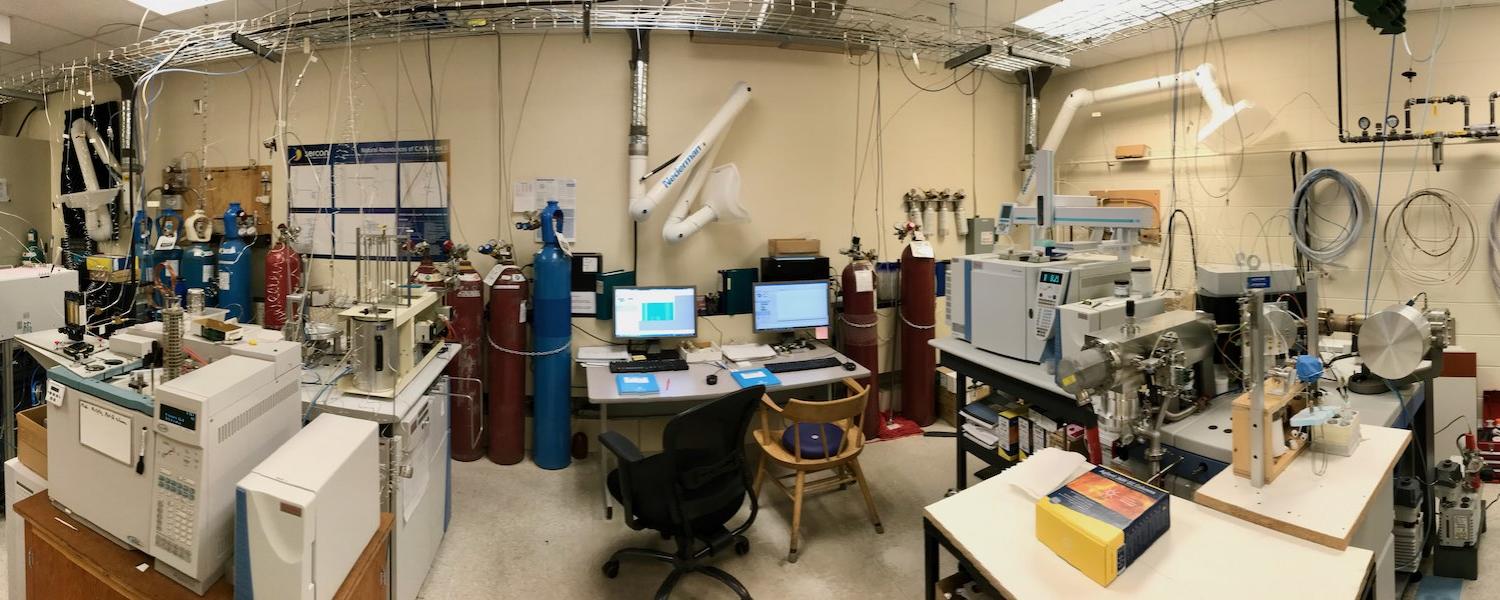
Isotope Science Lab
Precipitation of BaSO4 for δ34S analysis.
BaSO4 should be precipitated from natural waters (groundwater and/or surface waters) ASAP, preferably in the field shortly after collection/filtration. By capturing as BaSO4 (ppt), uncertainty about loss of sulfate ion due to storage and transport is avoided. It also allows you, as the principal investigator, to visually observe the amount of BaSO4 (ppt) captured and judge if more water needs to be collected.
Proceed as follows:
- Filter 1L of water through a glass fiber filter (~0.7 um pore size). Note: the amount of water sample required will depend on the dissolved sulfate concentration (something often not yet known). Two options: 1) test a smaller volume of sample water using the procedure below. If precipitate is clearly visible you can adjust your volume accordingly. 2) if dissolved sulfate concentrations are already known (previous study or historic data), adjust your volume accordingly. Note: 1L of water is a conservative amount and is usually enough to give enough BaSO4 ppt.
- Acidify the water to just below pH 2 by adding ~5mL of 3N environmental grade HCl (this can be adjusted depending on the alkalinity of the samples). Wait ~10 minutes to ensure that the DIC is driven out of solution (give it a stir or swish to aid).
- Add 5mL of saturated BaCl2 solution.
- Allow BaSO4 precipitate to settle (pure BaSO4 is a clean, white precipitate).
- Recover precipitate on 0.45um MCE (Mixed Cellulose Ester) type membranes. We use Millipore HAWP02500 or HAWP04700 because they are ashless.
- While the filter is still in the filter apparatus, rinse the precipitate with at least 500 ml of distilled water (ideally warm) to remove any residual BaCl2.
- Place filter in a scintillation vial or watch glass and dry in a dessicator.
- If you have captured “a lot” of BaSO4 scrape it carefully into a clear borosilicate glass vial with a good quality cap. Secure the cap with a small amount of parafilm.
- Be sure to pack everything well! (Poorly padded scintillation vials have been known to break during transport)
By acidifying the samples before adding the BaCl2 there should be no BaCO3 formed. Also, any detrital CaCO3 will have been dissolved.
The BaSO4 samples are captured on MCE type membranes so that if the amount of precipitate is very small, the filter paper can be fused (muffle furnace @ 800 ºC ~1hour). In such cases, it is best to dry the sample, fold the filter paper with the sample carefully and send it all in a capped scintillation vial to the ISL-UofC. We will perform the fusing. Care must be taken not to lose any sample during fusing.
How little BaSO4 precipitate can be measured?
Short answer: "Ideally" we appreciate receiving ~20mg of loose, clean, dry, homogenized BaSO4 in small clear glass screw top vials.
Long answer: <5mg BaSO4 is possible to measure, but difficult for a couple of reasons:
- When [SO4=] concentrations are low (<1ppm), 1 -2 L of (filtered) sample is needed to get enough BaSO4 (more work/cost/time spent collecting and filtering in the field)
- In such cases, as mentioned above, we recommend leaving the BaSO4 on the filter paper (always use MCE membranes). Also, if calculating from [SO4=] concentrations, remember that ~5 to 10% of the precipitate will be retained in the pores of the filter paper
- Once received at the ISL, we carefully scrape the BaSO4 off the filter paper using a stainless steel spatula and weigh it into Sn/Ag cups for EA-IRMS. Note: during scraping, some precipitate is often lost due to "fly away" caused by static charge. (Calgary is high and dry and static charge is a big problem in the lab)
- Finally, scraping the filter paper also causes problems because cellulose fibers come loose and add unwanted O to the bulk EA-IRMS measurement
Ultimately, we need 0.5mg for each of d34S and d18O measurements. So, while theoretically the bare minimum is 1 mg (of accessible BaSO4), in practice, we can't really work with less than 2 - 3 mg. We much prefer to receive more, rather than less. ~20mg is ideal, but >50mg is overkill. As mentioned above, we recommend that you, as the prinicpal investigator, do the precipitation of BaSO4 ASAP (in the field or shortly there-after). We also advise that after filtering, look really closely at the surface of the filter to be sure you see the BaSO4 ppt. This isn't easy, but if not even a thin film of precipitate is visible, you likely don't have enough. Also, using the smaller 25mm membrane rather than the 47mm helps to concentrate the precipitate onto a smaller surface area.
